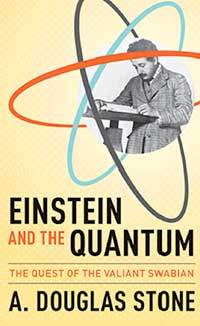Einstein and the Quantum: The Quest of the Valiant Swabian
By A. Douglas Stone | Princeton University Press, 2013, 332 + x pages, $29.95
Reviewed by Michael Riordan

Despite scores of books about Einstein and his scientific achievements, the well never seems to run dry. Perhaps it is a measure of his greatness. There are so many dimensions to plumb, it seems, that the source may be inexhaustible.
Yale University physicist A. Douglas Stone has opened up yet another vein in Einstein’s life and science, one we learned about as undergrads but has so far been paid insufficient attention: his pioneering work in quantum mechanics. Yes, we know he was the first to take Planck’s quantum seriously — and earned widespread derision for his boldness until the experiments of Millikan, Compton and others bore out his “wild hypothesis” during and after the Great War. That’s why Einstein was awarded the Nobel prize, after all, not relativity. But the focus of biographies and histories has remained upon his singular contributions to the special and general theories. Other physicists like Bohr, Heisenberg, Pauli and Schrödinger supposedly picked up the dropped quantum ball and ran with it.
In Einstein and the Quantum, Stone puts his hero back in the midst of the history of quantum mechanics, building a narrative around his three decades of contributions to the revolutionary theory. In consummate detail and with a flair for the written word, he delves into Einstein’s original rationale for espousing the quantum, his use of it to account for the mysterious behavior of specific heats at low temperatures, his explanations of spontaneous and stimulated emissions, and the derivation of the statistics of integer-spin particles. Readers benefit from Stone’s deep understanding of quantum physics as well as his thoroughness in citing primary Einstein documents — rather than regurgitating the opinions of others — to support his conclusions.
One surprise to me, given the famous Bohr-Einstein debates of the late 1920s, was how Einstein struggled for years with wave-particle duality, long before it became a centerpiece of the famous (or, depending on one’s viewpoint, infamous) Copenhagen interpretation of quantum mechanics.
On reflection, however, it seems a natural task for one — and he was probably the only one for at least a decade — who took the particle nature of light seriously. In the early 1900s, electromagnetic radiations such as X-rays and gamma rays were often found to behave like particles, not waves. How to account for this curiosity within the then-dominant paradigm, Maxwell’s theory?
Einstein’s early attempts prefigure to some extent Louis de Broglie’s later evocation of “pilot waves” to explain the wavelike behavior of matter particles. But he goes much deeper and further than just trying to formulate a suitable explanatory mechanism, invoking philosophical arguments and the gedanken experiments he later became famous for. To me, this is one delight of reading this fine book. Readers get to watch over his shoulder, as it were, as Einstein wrestles with seemingly paradoxical behaviors in face of stern opposition from reluctant classical physicists.
There are only a few books on the history of physics that I can heartily recommend to both scholarly historians and physicists interested in the history of their discipline. Because of Stone’s extensive research and writing abilities, Einstein and the Quantum is indeed one of those books.
Michael Riordan, author of The Hunting of the Quark and coauthor of Crystal Fire, taught the history of physics at Stanford University and UC Santa Cruz.
The articles in this issue represent the views of their authors and are not necessarily those of the Forum or APS.
